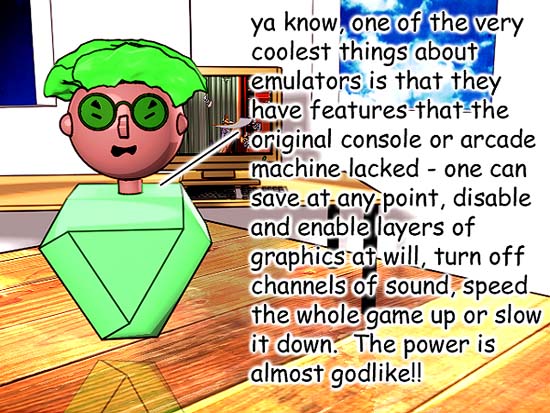 |
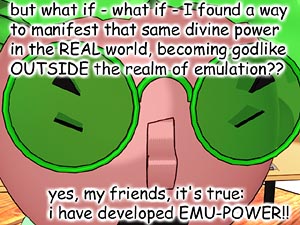 |
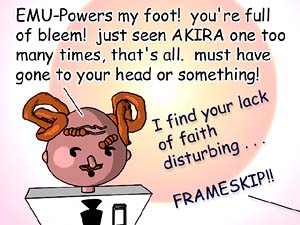 |
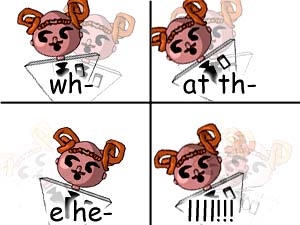 |
 |
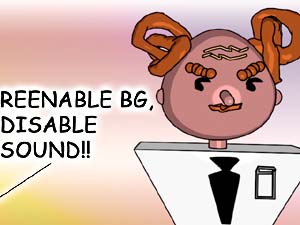 |
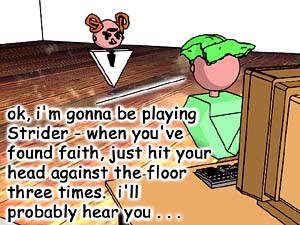 |
The problem isn't the rise of emulators. It's that there are too few of them.
FINAL EDITION
copyright (c) 1999 Sam Pettus (aka "the
Scribe"), all rights reserved
All copies must not be altered in any way, including but not limited to reformatting and conversion to alternate document formats, without the express consent of the author. The sole exception is for necessary formatting changes that may be required to adapt this document to suit your particular needs; however, the complete original text must be retained in as close a layout to the original as possible. For any questions in this regard, please contact the author.
No copy may be reproduced in whole or in part within a for-profit commercial publication or Internet site without the express consent of the author. The author recognizes the right of said vendors to reproduce limited portions of his work under the "fair use" clause of the appropriate sections of the U.S. Copyright Act and the Berne Convention for the Protection of Literary and Artistic Works.
Any trademark or other such indica to be
found within this document is the exclusive property of its respective
owner, and is reproduced here merely for the sake of reference.
Module 3: The Implications
Part 1 - In Defense
of Programming Freedom
NEXTGEN VINDICATIONOverClocked #30, "EMU-Power" © 1999 David Lloyd
The problem isn't the rise of emulators. It's that there are too few of them.
T. Liam McDonald, "You Will Be Emulated," MaximumPC, September 1999
On 24 August 1999,
Judge Charles Legge of the 9th District Federal Court in San Francisco,
CA, United States handed down what would prove to be the third and final
ruling in the preliminary round of Sony v. bleem LLC, one of two
landmark cases initiated that year with regards to videogame emulation.
Sony Corporation, the well-known international multimedia conglomerate
originally founded in Japan, had sought for a third restraining order against
bleem LLC, the makers of the bleem! PlayStation emulator for IBM
PC compatible personal computers. They accused the company of numerous
infringements and violations of Sony's intellectual property with regards
to the origins and operational functions of bleem! Chief among
their contentions was the same that they had successfully used against
Connectix (the makers of Virtual Game Station for the Apple Macintosh)
earlier that month, which was that bleem! unlawfully duplicated
portions of proprietary Sony object code stored within its Papillion ROM
(the PlayStation BIOS). In order to counter Sony's claim, bleem LLC
company president David Herpolsheimer made available to the court both
the source and object code forms of bleem!, as well as every single
document in his company's possession with regards to its origins, development,
and intended distribution. After considering the matter for some
time, Judge Legge ruled against Sony's request for a third injunction over
the emulator, citing bleem LLC's overwhelming evidence in favor of original
development, plus the fact that Sony had been unable to successfully prove
any of its claims. bleem! had finally cleared all legal hurdles
for unrestricted retail distribution and continued development up to the
date of the actual civil action, which is scheduled to take place in April
of 2000.
Herpolsheimer
wasted no time in making his opinions known to the public on the affair.
"This was a major hurdle for us," he said in an interview with GameSpot
News. "Sony had all the weapons on their side this time ... and
they still couldn't make a case against bleem!" In another,
somewhat earlier interview with EGM, he vented his feelings on Sony's
continuing efforts at stopping his emulator's market penetration.
"We're real confident. It's almost silly at this point - the attorneys
feel like there's just no point in going on. It's like, 'we've won.'
They feel really good about it ... [but Sony] could drag this thing out
forever. I hope at some point they'll stop." And in an open
letter to users of bleem! on the company's Web site, the following
statement was posted. "This is a great step for bleem! and
we want to thank all of you, because without you, we would have never made
it this far.... Thanks again!"
Emulation has
now come full circle. Sony v. bleem LLC and
Sony
v. Connectix are to the videogame console industry what the
A-Max
affair was to the personal computer industry a decade ago. Not only
do they uphold the legality of emulation as a non-infringing technology,
they also help to reinforce the guidelines whereby unauthorized emulation
of a proprietary vendor product can be lawfully conducted. While
proprietary-minded vendors may not be able to stop emulation, they certainly
have the right to object to what they perceive as overreaching infringements
on the part of the emuscene - or do they? There are those both within
and without the emuscene who would contend otherwise.
It is time to
revisit the controversy over emulation in the form of a formal "us-vs.-then"
debate. A lot of this material will sound familiar, as we have touched
upon it at times in our earlier discussions to varying degrees. This
time, though, I will stand back for the most part and act in the role of
moderator instead of author. I will let the opposing sides speak
for themselves, and let you be the judge as to the reason and logic of
their arguments. First we will hear from the emuscene, as their opinions
are often ignored or distorted by mainstream reporting. Next will
come the vendors, particularly from those who feel that unauthorized emulation
represents a direct threat to their bottom line. Finally, in the
third and last part of this module, I will resume my role as author and
share with you my thoughts and experiences with regards to the topic of
emulation.
MARKET PENETRATION
The one claim that offended vendors make against emulation time and again is perhaps their strongest one - that emulation adversely affects their intended market share. The emuscene sees things differently than does the vendor community, as one might expect, so let's hear what they have to say.
Emulation is at best a minimal threat to vendor profits.
In fact, a very strong case can be made that emulators have the potential to actually boost a vendor's profits. Consider the words of T. Liam McDonald in his recent editorial for MaximumPC, "You Will Be Emulated."INTELLECTUAL PROPERTYHow does [emulation] hurt the developers, who now have an entirely new market (PC owners) to sell to? Not one iota. It's the best thing that could happen to publishers. Or course, it may cut into PlayStation hardware sales, but how serious is that? Everybody knows that the profit is in the software, not the hardware. When Sony introduced the PlayStation, the machine was sold for close to cost in order to establish a user base for the true money train: the games. Thus their arguments for the damage emulators cause are hollow.Sony's sales approach is actually quite common and is not restricted to the videogame industry alone. Don Levine, the creator of G.I.Joe, calls it the razor-and-blades approach: "If you sell someone a razor, then they're going to need the blades." Thus it was that Hasbro first sold its "razor" back in 1964 - in this case one of four different basic G.I.Joe action figures, and then sold many different "blades" - multiple different accessory sets - to go with them. Those blades can be quite profitable indeed, with net profits in the multi-millions of dollars range. It is an open secret that most videogame console vendors, like Sony, sell the actual console at or just above cost (the "razor"), because they expect to make up the difference in program sales (the "blades"). A recent GameWEEK editorial on the impending arrival of the Nintendo Dolphin points out that Sony is claiming just over one-third of the end-retail cost of PlayStation games in royalties and other related indirect charges. If you think that's high, consider Nintendo, who claim back in royalties and other fees almost half the retail price of N64 games.
It is clear that the vendors are making money hand-over-fist in software sales, and third-party emulators designed to work with original system software (such as bleem! and Virtual Game Station) can actually boost those sales by opening up new markets hereforeto denied to the original system vendor. IBM PC compatible and Mac owners who wouldn't have given PlayStation games a second thought now have the option to do so - and many are, judging from initial sales figures for bleem! and Virtual Game Station. The same holds true for older systems as well, since many an emulator user goes on afterwards to seek out the original console and the actual original program base. Need proof? Just visit eBay's Computer Games section sometime and see the prices that both original systems and original copies of its programs are fetching. It will take only a few minutes browsing eBay's site to realize that the market for classic computing is rather sizable. A threat to profits? Not likely.Emulation permits experiences outside of a proprietary system.
McDonald's comments also bring up another point that the vendors don't care to discuss - that emulation actually allows users to enjoy programs outside of their intended platform. Mark Asher, writing for C|NET GameCenter, puts it this way: "What this denial of injunction [for Sony] means for gamers is simple: freedom of choice." Howard Wen, writing for Salon, calls it "tearing down the barriers for code among proprietary formats," and has a lot more to say about it in his article "Why Emulators Make Video-Game Makers Quake."
Emulators are finally bringing into question the need for [vendors'] specialized gaming platforms and dedicated gaming boxes in the first place. If every video game console is easily emulated on a personal computer, then what's the point in even having specialized formats in the first place?Sales figures for both of the commercial PlayStation emulators far exceeded initial projections, with bleem LLC reporting over 50,000 units of bleem! sold in the first month and Connectix reporting over US$1 million in Virtual Game Station sales every week for the first three weeks it was on the market. To quote Marc Saltzman, a regular columnist for C|NET GameCenter, "Clearly there is a market for commercial emulation software." L. Bank, author of the C.A.G.E. arcade emulator, words his thoughts on the matter rather bluntly.
Emulators herald the end of the era of the proprietary video game console because they render such dedicated gaming boxes technically superfluous. Emulation progress improves, PC hardware technology advances relentlessly - and the notion that games must be played on the console hardware for which they were developed is becoming as antiquated as an old Atari game system. Just as information wants to be free, code doesn't want to be restricted to running on a single format. That, not simple piracy, is what emulation is all about - and it's why the videogame companies want to squash it.Game manufacturers are only interested in the bottom line. They don't think releasing their old games in new forms is worth their time; thus, the only way to play these games is through emulation.There is also another factor to consider, and that is greater freedom in developing products for specialized systems. Again, Howard Wen.Additionally, computer and [video]game hardware companies might want to informally support the efforts of emu programmers [for development purposes]. That's what U.S. Robotics did earlier this year when it included the Palm computing device emulator Copilot in its development tools packet. The work of an independent programmer, Copilot benefits U.S. Robotics by encouraging software development for its PalmPilot line of personal digital assistants [PDAs]. While the emuscene is [busy] tearing down the barriers for code among proprietary formats, it can also support the intrinsic value of a piece of hardware by opening up development for it and extending its market life.This is exactly what certain proprietary-minded vendors such as Sony and Nintendo fear, because they have a nice little captive niche market for specialized development consoles and software development kits (SDKs) for which they can earn hundreds or even thousands of dollars apiece. Introduce an inexpensive yet highly effective emulator, and you eliminate those captive profits, as bleem LLC's David Herpolsheimer indirectly asserted when he was recently interviewed for GameSpot News. The report is by Sam Kennedy for Ziff-Davis Publishing.Several game developers have taken a strong liking to bleem!, according to Herpolsheimer. He's had several discussions with developers who have informed him that they have been using his product to develop or test their titles due to their blue PlayStations (development units used to play non-final titles) constantly failing to operate. He mentioned that developers designing titles to work on bleem! will automatically be fully functional on the PlayStation hardware with little or no tweaking. Herpolsheimer also pointed out that one of the largest developers of PlayStation software - one whose name he couldn't reveal - was developing with bleem! in mind and had just ordered several copies of bleem! to help test their products.Perhaps it is as Jean Guillaume Paradis said in a recent RPGamer posting. "Maybe the reason Sony won't [release their own emulator] is because they simply can't ... maybe it's because they're too stupid."Emulation does not promote software piracy.
The point that Howard Wen raised earlier about specialized systems is an excellent one and should not be ignored. The reason that proprietary-minded vendors are so afraid of emulation is that it is the harbinger of their doom. People will not spend money on their pricey proprietary systems when they can get the appropriate emulators for a lot less. Naturally, these vendors do not plan on giving in so easily, and the quickest and easiest attack is to issue blanket charges of software piracy. Again, we hear from the succinct wisdom of T. Liam McDonald, who briefly addresses this in "You Will Be Emulated."
The statement that the only purpose of emulators is "to play illegally copied games from the Internet" is just a lie. Once you buy a game, you can play it wherever and whenever you want. It's yours. If you want to patch together a lawnmower, a Watchman, and a pair of ice tongs to play Sonic Cruises for Hookers, or anything else that [the vendors are] publishing, that's your right.Howard Wen examined the piracy angle a different way in his Salon article, "New Life for Old Games."... for the copyright holders of pirated game ROMs, going after the emu programmers may be understandable but it misses the point. Extending the pirate analogy, emu programming at worst is akin to building ships favored by pirates. You can't stop the shipbuilders, because there are perfectly legitimate reasons for using ships - just as there are for emulators. Emulators enable code to be use across various platforms; they allow archived personal and business information - such as data that can only be read on an antiquated spreadsheet program that, in turn, ran on a long-defunct computer operating system - to be accessed on modern PCs.One can argue (and Nintendo resolutely contends) that the sole purpose of emulation is software piracy, but it's a blatant lie - just as McDonald asserts. Emulation has served a wide variety of functions and fulfilled a variety of needs throughout its long history. For example, if (as Nintendo contends) the sole purpose of emulation is to promote software piracy, then any product that contains one or more emulators must also promote software piracy. Microsoft will be the first to tell you that its Windows operating system contains several emulators, as do MacOS, Unix/Linux, BeOS, NeXTStep, and so on, all to allow the use of various functions that may not be supported by the platforms on which they may be installed. Do these products promote software piracy? Certainly not. Let's try another angle. There are certain videogame consoles that are "guilty" of including hardware emulators for back-compatibility issues. The Sega Genesis/MegaDrive may come immediately to mind, but others also suffer from this "affliction" and Sony's new PlayStation 2 will be the latest. If these consoles include emulation hardware, then they must promote software piracy, right? That is as ridiculous as it sounds. The emuscene responds to Nintendo's charge by quoting the space probe Nomad from the Star Trek episode, "The Changeling."Non sequitur - your facts are uncoordinated.
The next general charge that the vendors bring against the emuscene usually falls in the area of intellectual property infringement - that an emulator somehow or in some way infringes upon a vendor's patents, copyrights, or trademarks. The emuscene responds that such an act is possible with any program if its authors will it, but that is not their desire. They are looking to honor the vendors, not to walk all over them.
Emulation does not infringe upon a vendor's intellectual property rights.OPERATIONAL CONCERNSIt may shock the vendors to know that the vast majority of the emuscene is actually concerned about honoring the rights of the vendors whenever possible. Kevin Brisley, author of the Replay arcade emulator, puts it this way.
The bottom line is that companies have a right to defend their copyrights. If they want to force a ROM archive site to remove their images, [then] they're perfectly within their rights. However, my personal feeling is that they shouldn't alienate their past and current customers by quibbling over programs that haven't generated any income for them over the past 10 years."Along these lines, it should be noted that the last thing on the mind of many emucoders out there is the notion of "being exclusive," which is to the emuscene what a proprietary mindset is to the vendor community. Epsilon and RealityMan, the authors of the N64 emulator UltraHLE, took a lot of heat from the emuscene for not releasing their source. Six months later, there are several different N64 emulators, and one or two of these even have open source to boot. A proprietary mindset invites attack from others, and the emuscene's relationship with the vendors is no exception. As Howard Wen notes in Salon,...the programming skills of the emu developers will continue to undermine the incentives to make a new hardware format proprietary.The same is true whether you are a proprietary-minded vendor or an exclusive-minded emucoder. Cameron MacMillian is an Irish computer consultant who often does beta testing for the emuscene, and was recently quoted in Salon on the subject of exclusivity within the emuscene itself.Realistically, there's no point in being competitive. If one person withholds information, chances are a legion of [other] coders will eventually figure it out for themselves. Besides, what really is the prize for being first? Having your name in cathode ahead of everybody else's? Ultimately, it just delays the project.Emulation gives more respect to the original authors and programmers than do the vendors of their products.If you ever get time, then you need to drop by Emulators Unlimited (http://www.emuunlim.com) and go to the part of their site labeled, "The Dot Eaters." What you will find is a concise, well-written and illustrated history of the early days of computer videogames - from their beginning back in the early 1950s all the way to the "great crash" of 1983. It spares nothing on detail - dates, places, names, events, and so on. Many a programmer is listed there, along with the programs that they did, and they get far more credit than the vendors for whom they worked ever gave them during that time of old.
All of this ... and on an emulation site, too ....
It's not just limited to the mainstream emuscene, either. You can find Internet sites dedicated to all different kinds of software, or to just a single program, and many give ample credit to the authors - along with a copy of the program and the requisite emulator to run it.
Some of these programs haven't been available in decades ... imagine that ....
Odd, that this could be so, because one gets the impression from the vendors that these "pirates" never credit those who made the programs in the first place. Then again, those vendors are the same group who insist on exercising their "work for hire" rights whenever possible, rarely pay good programmers what they're really worth, and often find ways of not giving them credit for their work. Find this impossible to believe? Then go ask the programmers. They'll tell you that finding programmer-friendly employers is almost impossible, and they end up spending a lot of their time doing "hack work" for low pay and little, if any, credit. Rare comes the opportunity when they can tap the time and resources to be truly creative and produce the kind of product that users really want. Go ask them. They'll tell you the truth - not the vendor line.
Good programmers never fade away. They just earn newfound appreciation from a whole new generation of fans, almost always without asking for it, and this gives them the impetus they need for new creations. Emulation is good for programming, and not the other way around.
Another issue often raised by emulation critics is one of operational concerns. They fault the emulator for not working with this or that program, for running too slow or too fast, for failing to display subpixel cluster 2145 in high resolution mode on level 600 while engaging multiplayer gameplay, and so on. The emuscene is not blind to this criticism, and responds with two strong assertions of their own.
Emulation allows things that were not possible with the vendor's original product(s).PRODUCT EXPERIENCEIt can be claimed by the emuscene that classic computing has not only been successfully resurrected, but lives on in the form of emulation. In fact, as Howard Wen notes,
... emulators for most of the old videogame hardware - including the Atari VCS, ColecoVision, and Nintendo Entertainment System - were perfected long ago. All of the major brand home computers from the late 1970s and early 1980s - systems from Commodore, Apple, Atari, Tandy, and Texas Instruments - have also been resurrected in software form. These days, most emu programmers work on tweaking and enhancing their emulators.Tweaking, indeed! Many of these emulators are quite remarkable for the simple fact that you can do things with them that you could never do with the original hardware. Some of these were long desired by users at the time, and others have been added as a result of recent developments within the personal computer industry.
When Sardu of Bloodlust Software first announced that his team was going to add network play to Callus, their Capcom arcade emulator, everybody monitoring the emuscene thought he had lost his mind. His team pulled it off, the network play feature actually worked, and now network play is something that is increasingly becoming a standard feature among the more sophisticated videogame emulators. It should be noted in retrospect that none of the Capcom arcade games that Callus emulated supported network play. Now they do, but only under emulation. This is just one example of a new feature unavailable on the original system, but there are many, many more. Code the uncodeable, do the undoable, run the unrunable - in short, anticipate the impossible. This seems to be the operational maxim of the emuscene, and it is proven more and more with each passing day.Emulation permits the freedom to use older, smaller, more efficiently coded, and often better working versions of a given computer program.
Brad Oliver, a student at Arizona State University who has worked with both the M.A.M.E. and M.E.S.S. emucoding teams, makes the following comment about the emuscene.
I think hardware is still king, but emulation is proving [that] code is quite powerful in today's age of quantity over quality.Interesting observation! It is an established fact that many user prefer older versions of a program in favor of newer ones. A variety of reasons are offered, with size, familiarity, and reliability being the three most commonly cited. Older incarnations are smaller, are better known to the user, and don't have any "new or improved features" to jeopardize the program's stability. For example, many IBM PC users still prefer Microsoft Windows 95 or Windows NT to Windows 98 for precisely those three reasons. Win98 is massive, obtuse, and buggy compared to its older, smaller, better understood, and more reliable ancestors. Many of us who are in this camp will insist on continuing our use of Win95 or WinNT until something better comes along or we jump operating systems entirely to, say, Red Hat Linux.
Working Designs recently ported and released in English a special version of Lunar: Silver Star Story for the Sony PlayStation. It is an impressive upgrade of the original Sega CD release and well worth the price, yet you can still find the original release selling for original retail (or often higher) in eBay's Computer Games section. Why? Was it that good of an RPG? Certainly! Then why not buy the PSX version? Two reasons are often cited by current (and would-be) Lunar aficionados: the Sega CD original is not copy-protected (the Sony PSX version is) which makes it easy to back up, and Sega CD emulation seems to be an imminent reality. That last bit is important to defenders of emulation, as original Sega CD consoles are quite rare nowadays. Having a Sega CD emulator would save wear and tear on the actual console or permit playing of the game should an original console prove to be unavailable. Furthermore, the emulator would be working with an original Sega CD version of Lunar: Silver Star Story in its original format, which would nicely dispense with any claim of software piracy.
It should also be noted that the so-called "improvements" are sometimes little more than slightly retooled versions of the original running on the same basic program engine and executing in exactly the same fashion. What changes exist are slight, usually consisting of altered databases and altered graphics. Another increasingly irritating vendor tactic is to release a working, albeit buggy version of a program so everybody will be forced to contact customer support for the fix. T. Manelli recently vented his ire on the topic when interviewed by Marc Saltzman for C|NET GameCenter.I'm sick and tired of companies like Sierra and E.A. Sports releasing the same old crap year after year, save maybe for a few games like Half-Life or the NHL Hockey series. They expect gamers to shell out US$40 or US$50 for a computer game when it's not even finished, or there will be another version released less than a year later (in Sierra's case, six months later). I hope the rise [of emulators] gives all the suits at these fat companies a wake-up call, so they'll realize we've had it with being ripped off with their incomplete and rehashed games.
The question of product experience was first raised by Sony in the lawsuit against Connectix over the Virtual Game Station, but it has since been echoed by both other vendors and original programmers alike. They seem to be of the notion that if a program is not being executed on the original hardware using the original interfaces (joysticks, arcade console, etc.,) then the ultimate result is an inferior product experience. The emuscene does not agree with this contention, so their response is understandable.
Emulation enhances the product experience.NOSTALGIC YEARNINGThe rise of emulation technology permits users to experience a vendor's products in ways not possible before - a point that we have previously discussed. There are those who would say that making these new options available actually enhance the product experience, because it allows the user to become involved with the product in new and unique ways beyond those conceived by the vendor in the first place. Howard Wen puts it this way in his Salon editorial.
Despite [claims of emulator-enabled piracy], something other than copyright and intellectual property violation is bugging Sony and Nintendo. These companies are fighting to reinforce the boundary separating the console and computer gaming worlds.Naturally, loss of that boundary is something that like-minded vendors do not want to happen. If users become accustomed to the emuscene and both the promise and versatility that it offers to the product experience, then they will begin demanding it of future products. This will drive up product costs, thereby affecting the bottom line and reducing profits. Better to destroy emulation, thereby removing it as a threat and keeping the user base enslaved to a proprietary system irrespective of what the desired product experience might be. It is the vendor's product, not the user's - therefore the vendor should dictate the product experience instead of being dictated to by the user. That is the impression that the emuscene is getting from the vendors in this regard.Emulation allows a user to experience the "missing parts" that were delivered to other markets within a given product line.
Many who regularly monitor the English language videogame scene were surprised to see a four-year-old Japanese RPG for the Super Famicom (aka Super Nintendo) break into the American "top ten" lists for a time. The program was Seiken Densetsu 3 by the noted RPG maker SquareSoft, but is better known to English-speaking fans as Secret of Mana 2. According to SNES historians, SD3 (as it will hereafter be abbreviated) was one of many excellent RPGs that never made it to American shores due largely to the bungling of SquareSoft, its vendor. SquareSoft cancelled the translation of SD3 when it was only two-thirds complete, opting instead to release the inferior Secret of Evermore. The market demand was certainly there for SD3, but the vendor did not see fit to port the product, with the continued cost of translation cited as the chief factor.
Enter emulation into the picture some three years later. The reason that SD3 jumped into the charts is that a team of dedicated SNES fans founded their own group, translated the entire game into English, created a translation patch for the "ROM" version of the game, and then put it out on the Internet. For the first time, fans of the first Secret of Mana who had been clamoring for years to SquareSoft to finish the English port and release it could now finally enjoy the product that they had wanted and pleaded for to SquareSoft for so long. Was the wait worth it? "YES!" they almost unanimously shout. Dan Duett, writing for RPGamer, had this to say about the whole SD3 affair.Now anyone who is involved in the emulation world, such as myself, and particularly the translation world, knows that the translation of [SD3] is a massive achievement. This was a project which took over a year in itself and its history included many failed attempts. Now someone finally comes along and translates the game - not to make profit, [nor] gain attention, but to simply bring a game over to the States that should've been here 4 years ago. To top it off they overcome [sic] several complicated problems in the translation project, and even perform a better translation than many SquareSoft games of today. How can one say they're at fault? They should be congratulated for doing something [that needed] to be done ....Brad Carsten, also writing for RPGamer, put the matter more succinctly.
... do I believe that anyone who plays [the translated SD3 ROM] is breaking the law? No. They're simply playing a game that should have been played a long, long time ago....I believe emulation is a great way to play games that you couldn't play otherwise. [The vendors aren't] losing any money because I wouldn't be able to buy the games anyway.Dementer of the translation group DemiForce agrees.Without emulators, I never would have found this niche. It enabled me to take games that were far too rare to ever dream of getting my hands on in the physical world, play them, and translate them into English ... thanks to people like me, many games that were rejected for professional translation and release in English-speaking countries now can be understood and played by the entire emulation community (and those who own console copier devices).
Finally, there is an issue that a lot of us older computer and videogame users must raise: emulation satisfies and preserves our shared past for future generations to experience on their own terms. "Today's games suck," says L. Bank of C.A.G.E. fame, and many of us older users believe he makes a valid point.
Emulation lets older computer users enjoy the products that they know and love.INTROSPECTIONFor those of us who grew up as part of the personal computer revolution back during the 1970s and on through to the mid-1990s, there is something to be said for reliving the excitement of those days. Brad Oliver puts it this way.
[What this is] really all about [is] playing the games and reliving good memories. You can emulate the games, but you can't emulate the experiences. That sounds ridiculously cheesy, but hey - so was Dig Dug.Chris Baker, writing for the Austin Chronicle, has a slightly different take on the matter:Maybe like all other retrotrends - clothing, music, film - the rise in the interest of retrogames is just another example for the need for the familiar comfort of childhood. Or, maybe when you get down to it, the games were just better then.There is an ingrained human instinct to yearn for what many a psychoanalyst has termed "the simplicity of the past." This applies to computer systems just the same as it does for anything else. If I may break in and indulge for a moment in my own memories, I like emulation because I know those systems and I know that software like the back of my hand. Obsolete? Certainly. The games of yesteryear are still fun because of their deceptive simplicity. They may look old, grainy or blocky, painfully 2D, and ugly as sin compared to today's new, razor-sharp, texture-mapped and antialiased polygonal 3D "gaming experiences," but more than one has subtleties to its gameplay that escape even the slickest-looking modern offering.
You know, as for myself, I get the biggest kick sharing the past with the next generation of young gamers as they discover for themselves the old software that made possible the offerings from which they can choose nowadays. And you know what? They grow to love 'em just as much as they do the new stuff. Some even prefer the old stuff over new offerings. Case to point - my nephew must have every single rollerblade or skateboarding title ever made for the PlayStation or N64, but do you know what is his favorite game of this genre? Skitchin', by Electronic Arts for the Sega Genesis. He used to rent it from the local Hastings on a regular basis until he accidentally broke the RF modulator on his console. His parents bought him a PlayStation that Christmas, and a N64 a year later, but he never forgot that game. He rediscovered his love for the game after I became involved in the Sega emulation scene and obtained the cart dump, and it was all I could do to keep him off of my computer on the weekends he would drop by to visit. This year, he made it clear that I absolutely had to buy him an original cart for his Genesis after I had repaired it and got it working again. While I now have his Genesis (his parents recently gave it to me), he still plays Skitchin' for hours on end every time he drops by to visit. Case closed.Emulation preserves the past.
In the real world, hardware decays with the passage of time. There will eventually come a point where original systems will not work anymore because they are too old. What then? We open the discussion on this final topic with the words of Chris Baker, who makes an interesting observation in this regard:
Retrogame fans, like all fan bases, combine a childlike sense of enthusiasm with the grownup's desire to understand, articulate, and pass on that enthusiasm. Ultimately, it's the intensity of the fans' enthusiasm that saves retrogames from simply becoming a piece of history.Again, the words of T. Liam McDonald.Gaming, like any form of entertainment, has a heritage that is completely out of reach for today's consumers. A few issues ago [in MaximumPC], I lamented the industry's practice of making great games instantly disposable by rushing to the "next big things." The early days of Atari, Commodore, Sega, Intellivision, Apple II, Jaguar, Lynx, and ColecoVision are lost to current and future generations without emulation. N64 and PlayStation will one day suffer the same fate as NES and Sega Genesis.And now a word from the legendary creator of M.A.M.E., Nicola Salmora.Most importantly, our work is culturally significant: we are trying to preserve all these games for future generations. Emulation is the only viable option, because it's too hard to keep the original boards in working order .... If we don't do it now, and do it quickly, many games [are at] risk [of] disappearing forever.Add to that the sentiments of the mysterious "Dave," webmaster of the premier emulation website Dave's Video Game Classics.I feel [emulation] benefits developers, especially of older games, simply because it gets people interested in these old games that would otherwise be forgotten.Let us also add to that the sentiments of emu programmer Kevin Brisley.I would love to see companies offer their ROM images for a nominal fee.So would many of us, Kevin! In fact some vendors and original program authors have even taken your idea and done it one better - they offer their old programs in "ROM" format at no charge! Some do it for the sake of charity, while some do it to promote new and enhanced versions of the product for newer systems. These in turn are copied by the emusites, mainly because not every emufan has the habit of dropping by vendor websites. As a result, the emuscene gains legitimate commercial ROMs (which I term "inactive commercial") to use with the appropriate emulators.
Howard Wen touches upon this idea in his Salon article.... What better way to plug your company's new games than by giving old titles away that are no longer bringing in significant, if any, revenue? ... The company could provide users with access to the ROMs only after seeing online promotions for the new game, filling out a demographic survey, and/or agreeing to be put on an email list announcing new products.Let's be fair to the vendors, now. Many were re-releasing classics from their archives long before the current emulation boom, and many have jumped on board since. Atari ... Williams ... Midway ... Namco ... Konami ... Capcom ... Sega ... all of these have re-released classic videogame ports or packs within the past decade for newer systems, and it surprises no one that an increasing number of them are actually employing emulation in some form to run the original (or sometimes slightly tailored) videogame program code. At least one of these, the Sega Smash Pack, was derived directly from an emulator (Steve Snake's KGen) that was available to the emuscene long before the commercial product arrived. Even so, obstinate holdouts like Sony and Nintendo remain, and they do little to champion their own cause by unfairly targeting those who prefer their older products over their latest offerings.
It is clear in
the minds of everyone involved in the emuscene that emulation is a necessary
and vital part of the computer industry. It is a technology that
should not be shackled by the chains of vendor desire, nor should it be
hobbled by the designs of vendor strategy. The vendors have yet to
raise a valid charge against the emuscene, and it is because they cannot.
They know the truth, but would deny it not only to themselves but to the
rest of the computer industry as well. Like stubborn children, they
refuse to accept that which they hold unacceptable.
Face it, vendors.
YOU WILL BE
EMULATED.
REVIEW QUESTIONS
1. Why is the "razor-and-blades" approach to product marketing so effective? Which makes more money, the "razor" or the "blades?" Why?
2. Why is there such a sizable market for classic computing?
3. What is the biggest threat that emulation poses to proprietary-minded vendors, and why?
4. Explain why the emuscene feels that emulation does not promote piracy.
5. How does the age of a given product factor into its treatment by the emuscene?
6. Does emulation truly affect the perceived "product experience?" How? Is this necessarily a good thing?
7. How does emulation enable users to escape the bounds of a vendor's fixed market for a given product?
8. Why do some computer users prefer old products over new ones? Give examples to justify your answer.
9. Why is the emuscene so important to the preservation of computer history?
10. Why should the vendors embrace emulation?
THOUGHTS TO PONDER
1. Why are vendor royalties for their products set so high?
2. Is there any truth to the charge that emulation promotes software piracy? Why or why not?
3. Is recognition of original authorship a valid part of the great emulation debate? Why or why not?
4. Why do perfectly good products get so-called "upgrades" that are little more than fancy make-overs?
5. Who should dictate the "product experience" - the vendor or the user? Why?
6. Do you see the rise vendor-sponsored ROM sites as a good thing? Why or why not?